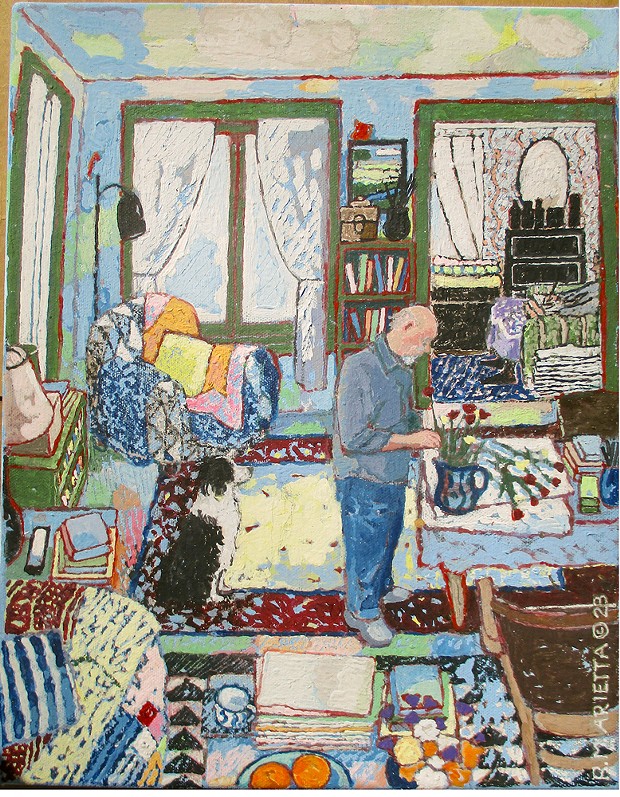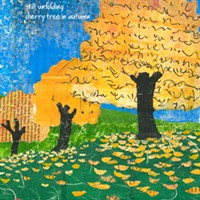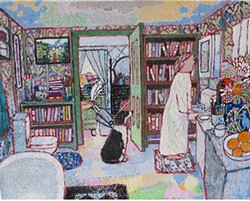
"Arranging Flowers" by Ruth Arietta, 2023, acrylic on canvas, 14-by-11 inches.
[
{
"name": "Top Stories Video Pair",
"insertPoint": "7",
"component": "17087298",
"parentWrapperClass": "fdn-ads-inline-content-block",
"requiredCountToDisplay": "1"
}
]
Ruth Arietta paints both outdoor and indoor scenes, but it's the paintings of domestic interiors that showcase the particular strengths of her approach. In these works, densely patterned surfaces negotiate new relationships with the rectilinear volumes set up to contain them. Sometimes they abide within the constraints imposed by floor tiles, window casements, picture frames and crown moldings. Other times, they float unencumbered by Euclidean geometry. The view into these small acrylic and gouache paintings is distanced, as if peering into a doll's house. They're yours to peer into in her Narrative Paintings & Fanciful Sculpture show Aug. 13 through Sept. 24 at the Morris Graves Museum of Art.
"My paintings are meant to convey a complete picture of happiness and being contentedly human," Arietta has stated. "The thoroughness is a meditation on a human situation. It is about a person who is in good condition and right where they should be in their life and existence."
Arietta paints lived-in, cared-for interiors that are appointed with comfortable furniture, desktop computers and paraphernalia relating to painting, drawing and sewing. Their shelves groan beneath tottering stacks of books and records. Familiar armchairs, rugs, bookshelves, curtains, sinks, bathtubs, toilets, floral arrangements and papered walls get redefined as components of a contiguous support where patterns and prints run wild.Both walls and ceilings are visible in most rooms Arietta paints, and most works are composed from a modestly elevated perspective. They employ multiple strategies to represent space. Some aspects of interior architecture are represented in linear perspective, while others are rendered as flattened abstractions. Orthogonal lines recede toward elevated vanishing points, but other aspects of the compositions downplay optic realism for effect. In "Arranging Flowers," the black and white tiles on the floor maintain their dimensions without diminishment; the red arabesque brushwork around the rug border does not recede into space, either. In "Now Sleeps the Crimson Petal," goldfish that school on a shower curtain come unstitched from their origin and swim across the room. The spines of volumes in the bookcase glow like neon lozenges. Stippled flights of brushstrokes telegraph intensity, bedazzling the banal.
Arietta's no-holds-barred embrace of pattern and decoration recalls the early 20th-century innovations of Édouard Vuillard and Pierre Bonnard; the bathing figure visible in "Now Sleeps" certainly summons Bonnard's shade. Likewise, her impasto technique is indebted to some of the luminaries of early 20th-century French modernism. Everything here is charged by color, which makes it hard to discern a light source. The stipples denoting the inside are as brilliant as the ones showing the world outdoors.Brushstrokes cover surfaces in uniform drifts, orienting in accordance with the shapes of the objects they describe. Uniform white slugs describe the curtains in one painting, while similarly scaled interlocking strokes in pale blue form the more proximate table at center right. The table is outlined in crimson, as are the books and papers piled on a smaller table in the foreground, as are the windows and the contours of the architecture. What makes the room feel curiously dreamlike and insubstantial is the patterned field appearing behind objects in the picture's lower half, which reemerges unexpectedly to flow across the room's ceiling as well. This has the effect of dissolving the divide between indoor and outdoor space. The expanse of blue is mottled with paler patches that might be either continents or clouds, in shades like silver, lime, peach and citron. It makes an appearance in other paintings as well. Walls melt away; elements of indoors and outdoors mingle. Even so, Arietta's lens can tighten abruptly on unexpected details, like the hairpins, scissors and comb that rest on the edge of the bathroom sink in one work.
The COVID-era painting "Still, We Have What We Need" does away with fixed spatial coordinates. Furniture pieces associated with different rooms occupy adjacent sectors of the same space: Bathtub, toilet, sofa, bookcase and sink cohabit as if an interior wall keeping them separate had been dissolved. A gray-haired woman in a long nightdress stands in profile at the kitchen sink, surrounded by a riot of pattern. The room's most fully embodied denizen is the sheepdog who sits at the composition's center, like a black and white anchor.
The animal familiars that appear in most of these works may be the only ones hip to the fact that they exist within an illusion. They are undeniably cute, especially when they look out of the painting and meet our gaze, breaking the fourth wall. Fortunately, the paintings' distanced and slightly inhuman point of view cuts the whimsy. Interiors are composed as if they had been recorded by a roving eyeball, hovering unseen in the doorway of occupied rooms. They seem to speak to the idea of the world as being alive with unseen spirit. "The painter needs to be like the fool in the tarot cards stepping blindly over a cliff," Arietta writes in her artist statement. "This is a spiritual process."
Gabrielle Gopinath (she/her) is an art writer, critic and curator who lives in Arcata. Follow her on Instagram at @gabriellegopinath.
Speaking of...
-

Music Today: Sunday, Feb. 18
Feb 18, 2024 -

Annette Makino's Life in Collage
Dec 21, 2023 -

Truth Units
Sep 7, 2023 - More »
more from the author
-
Nancy Tobin's CRy-Baby Installation at CR
- Feb 22, 2024
-
Truth Units
Bachrun LoMele's Burn Pile/The Andromeda Mirage at the Morris Graves
- Sep 7, 2023
- More »
































